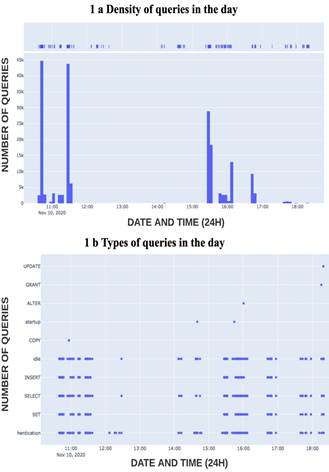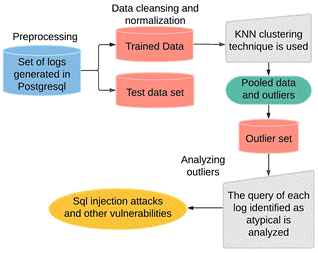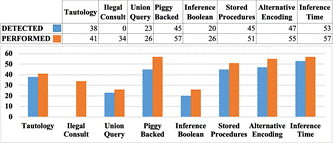INTRODUCTION
In any business organization, business database and storage infrastructures contain primarily sensitive data, which are targets of a wide range of attacks on their security by users seeking to take advantage of that information for different purposes (Malik y Patel, 2016). The most common attacks are due to the wide range of vulnerabilities of databases. They are mainly due to the lack of visibility when they occur at the database level and to the scarce analysis of vulnerabilities. An example is the inadequate management of user rights and the lack of monitoring for unauthorized access (Telefónica Company, 2015).
Modern security vulnerability detection applications must be reliable, functional, and easy to manage. In recent years, intrusion detection systems (IDS) based on data mining have demonstrated high precision, good generalization of new types of intrusion and robust behavior in a changing environment (Chetan y Ashoka, 2012). In addition, the security incident response and intrusion identification engines are gaining relevance given the growth of malware and various threats that databases are exposed to.
Research in intrusion detection methods relies on statistical models. Lee et al. (2000) analyzed log regular expressions from SQL queries to identify the normal behavior of users. Wang et.al (2020) proposed an automatic neighbor selection based on the kNN (k-Nearest Neighbors) algorithm. Making clear emphasis on showing that supervised learning methods have a higher efficiency than unsupervised methods and explaining the advantages of using a machine learning algorithm, such as kNN, for anomalies detection with massive log files. Brahma and Panigrini (2020) analyzed outlier values using data mining techniques to automate the intrusion detection process with greater precision, using data generated from database users. We consider these mentioned studies to be the primary source of our project development, we combined a hybrid approach of SQL regular expressions analysis for identifying specific types of injections and outlier detection to decrease the complexity of working with large datasets.
This paper presents the results of a project to implement a model which identifies SQL code injection attacks through the analysis of various PostgreSQL transaction logs using the kNN data mining technique to detect atypical queries. This solution was based on the observation that the transaction record of an injection attack has a considerably different duration time than a typical transaction and generally other types of SQL instructions. The authors also developed a plain-text analysis function to identify each type of SQL injection attack. The results showed that the algorithm correctly identifies most tested SQL injections.
2. BACKGROUND
a. SQL Code Injection
SQL code Injection attack is defined as an attack that is carried out on a web application. The attacker enters SQL code in an input box (web form) to obtain illegal access to the application (Kumar y Pateriya, 2012).
b. Types of SQL Code Injection
Tautologies: In this type of SQL injection, the attacker can inject malicious code into the query based on the conditional "or 1 = 1" that will always be evaluated as true (18.
Logically Incorrect Queries: The attacker takes advantage of the invalid queries that were run with an error message to obtain information about the tables or data types (Varshney y Ujjwal, 2019).
Inference Boolean injection: The attacker draws his logical conclusions from a true-false question thrown into the database (Varshney y Ujjwal, 2019).
Inference Time-based: It is an inferential SQL injection technique that is based on sending an SQL query to the database, forcing the database to wait a specific amount of time (in seconds) before responding (Varshney y Ujjwal, 2019).
Union Query: The attacker adds malicious code to a second secure query using the "union" operator to obtain information from the table of interest in the database (Varshney y Ujjwal, 2019).
Piggy-Backed Queries: In this type of SQL injection, the attacker manipulates the data using the clauses: INSERT, UPDATE and DELETE without altering the logic of the original query (18).
Stored Procedure: The attacker integrates malicious SQL injection codes into existing stored procedures in databases (Varshney y Ujjwal, 2019).
Alternate Encodings: The attacker uses different encodings such as hexadecimal, ASCII, or Unicode to confuse the SQL statements avoiding basic validation (18).
c. Types of anomaly detection techniques
Table 1 compares the different data mining techniques to detect anomalies, their advantages, disadvantages, and the type of algorithm each technique follows.
METHODOLOGY
In this study, the CRISP-DM methodology was adapted and applied to identify, select, process, and analyze the development of our artifact, which is the tool for intrusion detection. The steps that were carried out are the following:
a. Problem Understanding: It is crucial to understand the objectives and requirements of the study
b. Data Understanding: Collecting quality data that brings us closer to the problem. Data is then scanned and verified, and unnecessary data is discarded.
c. Data preparation: Data is prepared, cleaned, and integrated into an appropriate format for the data mining technique used later.
d. Modeling: This phase focuses on selecting the appropriate modeling technique for the data mining project that is being developed
e. Model Evaluation: Evaluate that the steps of the model are carried out correctly and measure that each result obtained is following the objectives.
f. Visualization: The final phase allows observing the system prototype data mining model
3.1. Problem Understanding
This study aims to develop a system prototype that allows the identification and prediction of events of SQL injection attacks on PostgreSQL database servers.
An extensive bibliographic search was carried out in files, documents, books, among other references.
We needed reliable and accurate information, we consulted scientific studies from virtual academic libraries such as Research Gate, Google Scholar, among others, to know the advances in this field. Also, in this step, the programming language we will use is analyzed. Finally, it is verified that it has the necessary libraries to process large amounts of data to solve the problem.
The literature reviewed suggested that the authors should focus on increasing its accuracy and efficiency at the network or operating system level (Hu y Panda, 2004). Other documents of interest described approaches of different authors that brought us closer to understanding the problem. Lee et al. (2000) proposed a database intrusion detection method that looked at frequent temporary data access.
Muslihi y Alghazzawi (2020) proposed a probabilistic SQL injection detection technique through deep learning techniques. Brahma y Panigrahi (2020) used fuzzy logic in the intrusion detection behavior model in the database to identify intrusion on PostgreSQL databases. All of the above research is based on statistical methods. But data mining techniques are showing their potential in database-based intrusion detection.
3.2. Data Understanding
The data of interest in this project are plain text files containing sets of transaction logs generated daily by the CSIRT (Computer Security Incident Response Center) PostgreSQL server. The log transactions generated in PostgreSQL are written daily in a formatted file (.log) to be transformed into new files (.csv). For this, a VMWare Workstation 16.1 virtual machine with Windows 10 Operating System was used, and PostgreSQL version 9.5 was installed, which is the database management system of interest in this project. The first test data we worked on was 62 Megabytes of the transaction log.
The list below describes each unique value in the PostgreSQL configuration file for transactions log that simulates normal behavior.
% d: Name of the database that is being used to run the queries
% u: Name of the user who connected to PostgreSQL server.
% r: Host and remote port. The client making the connection must be on the same machine as the PostgreSQL server.
% p: ID of the process. Unique identifier assigned to each transactions log
% m: Timestamp. It is the timestamp that includes milliseconds.
% s: Is the transactions log on timestamp.
% i: The command label returns the statement, such as: SELECT, INSERT, UPDATE, DELETE.
3.3. Data preparation
In this stage, the input data is processed so that it can be used in the chosen data mining technique, in this case kNN.
The steps we follow for data processing are detailed below:
3.3.1. Data Collection
Table 2 lists all the data selected and created from reading the log transaction set. The transaction log is collected in a text file format(.log) that is initially unstructured, so we read the file line by line to extract the data from each log using the libraries: pandas, CSV and Python as a programming language.
The files generated from this reading process are a document (.csv) with the attributes described in Table 2 and a separate text document where the LOG_ID and the RESULT of each set of log transactions are stored for later analysis of the type of attack in the evaluation stage.
This step is crucial because it is unnecessary to use the sort technique to have a long string of text, such as the query statement for each transaction record. With the new CSV file, the PyOD tool allows us to preview the transaction log in the Cartesian plane according to the chosen variables without needing to make prior changes to the normalization of the values to observe them graphically. This phase helps to understand the behavior of the transaction log to have a clear view of the best variables that can be used to identify anomalies.
Figure 1a shows the number of log transactions generated inside the database per hour. Based on this graphic representation, we can see that there are certain hours of the day when the queries made to the server are less active. Figure 1b shows a different plane in which the type of query performed by the log transactions in the database is displayed. It can be seen in detail that throughout the day, the most unusual commands are UPDATE, GRANT, ALTER, COPY.
In Figure 2, generated by the pyplot library, we can see a high density of transactions log generated in each query to the database for each hour of the day. It is necessary to know the dimension of the data to be processed and how to use it efficiently (Brahma y Panigrahi, 2020), that is why we present the density of queries done within the hours as shown in Figures 2a, 2b and 2c. These graphs helped to understand what type of values are most important in the generated log transactions and use them in the mining model, which will appropriately identify a behavior different from the normal one (Charania y Vyas, 2016).
3.3.2. Data Cleaning and Normalization
Certain log transactions collected with null values on the query date and time were eliminated so as not to interfere with the identification of anomalies.
Once the unnecessary columns and null values in the log transactions have been eliminated, taking into account the data analysis carried out with the PyOD tool using the kNN technique, we decide to generate separate files of 5 000 log transactions in each file. With each file generated in the previous steps, we normalize them. This means reshaping their data space so that their distribution along the Cartesian plane dimensions is approximately the same.
The traditional normalization method used for kNN is minimum-maximum normalization. Minimum-maximum normalization subtracts the minimum value of an attribute from each attribute value and divides the difference by the attribute range. These new values are multiplied by the new range of the attribute to get the time of execution and the time of the day and finally added to the new minimum value (Cho, 2002). These operations transform the data into a new range (0,1). As can be seen in the formula;
Where:
Xnew: Normalized Value
Min(x): Minimum value of the characteristic
Max(x): Maximum value of the characteristic
3.4. Modeling
Data analysis is the third stage, where the model is applied to detect SQL injection attacks. The steps followed are these:

Figure 2 Log transactions duration and query time in the day (2a) Zoom1, (2b) Zoom 2 and (2c) Zoom 3
3.4.1 Anomalies Identification on Prepared Data
To identify anomalies (outliers) within a data set we use the PyOD library. This process is performed after the log transaction set has passed the data transformation and cleansing process. For this identification, a comparative evaluation between several algorithms was first carried out to understand how kNN works and why this algorithm was the best option in this project. This comparison is listed in Table 1 and supported in the introduction. kNN was used within a plane comparing the query duration milliseconds and the query time in day. The duration of the executed query is the most critical factor in identifying database server injection attacks (Gong et al., 2019).
kNN Algorithm
The kNN classifier is based on a distance function that measures the difference or similarity between two instances (Wang et al., 2020). The standard Euclidean distance "d (x, y)" between two instances "x" and "y" is defined by the formula:
Where:
x: i-th highlight of the instance
y: i-th highlight of the instance and is the total number of features in the data set
It must be considered that the kNN algorithm is a non-parametric prediction method. This means that it does not require the elaboration of a previous model. To make a prediction, the kNN algorithm does not compute a predictive model from a training data set as in linear or logistic regression. Therefore, for kNN, there is no actual learning phase. This is why it is generally classified as a lazy learning method (Wang et al., 2020).
Figure 3 shows the implementation of the kNN (k-Nearest Neighbor) algorithm used for the atypical queries identification.
The result of the aggrupation and anomalies identification is shown in Figure 4. The figure shows X and 'Y-axis normalized values. The black dots represent the anomalies detected by kNN, and the dots inside the red line, or colored white, represent the regular transactions log.
3.4.2. Queries Text Analysis
The transactions log identified by the implemented algorithm as anomalies are stored in a new file. In this file, we found which anomalies are eventually a malicious attack, using text analysis on each query string to identify statements that are different from regular queries.
The following list shows the expressions used on the URL of the database server to simulate SQL injection attacks. Each query was tested with the model to identify the expressions on the SQL query.
Tautology:
http://localhost:3434/users.php?name=gabriela and 1=1--+
Logically Incorrect Queries:
http://localhost:3434/users.php?name=gabriela and select * from gestion.ges_catalogo where cat_nombre = ‘belleza’latina’
Union Query:
http://localhost:3434/users.php?name=gabriela and union select prov_ruc, prov_razon_social, 22 from activo. proveedor where '1'='1' --+
Piggy-Backed Queries:
http://localhost:3434/bodegas.php?name=BODEGA1; drop table gestion.ges_usuario --+
Inference Boolean injection:
http://localhost:3434/bodegas.php?name=bodega1 and declare @s varchar (8000); select @s = prueba (); if (ascii (substring (@s, 1, 1)) & (power (2, 0))) > 0 waitfor delay ‘0:0:5’
Inference Time-based:
http://localhost:3434/users.php?name=gabriela pg_sleep(15) --+
Stored Procedure:
http://localhost:3434/users.php?name=gabriela and select *from gestion.ges_usuario where usr_nombre = '' and usr_password = ''; drop table gestion.ges_usuario --+
Alternate Encodings:
http://localhost:3434/users.php?name=legalUser? exec(CHAR(0x73687574646f776e)) -- AND usr_password='' --+
These listed SQL injection attacks have unique text expressions, and in this way, the authors were able to identify what type of SQL injection it is.
3.5. Model Evaluation
After establishing a classification model with defined test data, the next step is to determine how effective the implemented algorithm is in correctly identifying the transactions log that leaves traces of an SQL injection. For this, 50 SQL injection attacks were simulated on our PostgreSQL-based server. The result was obtaining 100 log transactions, 50 having SQL injections registered in the queries of each log transaction, and 50 log transactions with 'normal' behavior without any hint of attack. The results were as listed below in Table 3:
Where:
TP: True PositiveTN: True Negative
FN: False NegativeFP: False Positive
The evaluation values reflected that:
Out of 50 known attacks in the log transaction set, 42 were identified by our model. While eight were discarded as normal behavior. Although the model has desirable accuracy, it could leave multiple attacks unidentified in a large data set.
Percentage results for accuracy, precision, and sensitivity are nearly even. So, we can reiterate that the implemented model works.
3.5.1. Text query analysis evaluation
This section presents the results of the SQL code injection attack tests of the developed model. In Figure 5, we can see a summary of the number of attacks carried out by each type of injection and the number identified by the system prototype. The graph shows that in various injection types, the model performance is effective for this project.
We can see that the percentage of identification of each type of injection exceeds 76% of cases except for the type of injection of "Illegal Queries", the main reason is that the attacks are based on the error response, and there is no specific SQL command that can be detected (Chaki y Mat, 2019).
These percentages agree with the results of the performance calculation obtained from the implementation of the kNN based classification algorithm shown on the model evaluation. Although the obtained training set can achieve a good balance in size and precision, there is still some noise data, which will affect anomaly detection accuracy to a certain degree. If the precision of the automatically selected training set can be improved, the accuracy of the anomaly detection model will be further improved.
3.5.2. Load testing
The following four steps were the evaluated stages of the CRISP-DM implementation with the log files.
1. Data Collection
This step collects the data from the entered file, transactions log reading, attributes extraction, and generation of new files. These files will contain the data of the extracted transactions log in a format established for the next step.
2. Data Separation
This step performs a division log, where files are generated with a maximum of 5 000 transaction sets each.
3. Data transformation and Algorithm Implementation
Each of the transaction sets generated in the previous step is captured, cleaned, and normalized for implementing the kNN algorithm. This step results in the generation of new files with the transactions identified as anomalies.
4. Text Analysis
A text analysis of the query made to the database associated with the log transactions identified as an anomaly is performed. In case of registering any expression that reveals the existence of an attack or its attempt, the anomaly registry is sent to the system server.
This evaluation consists in measuring the execution time of each step explained by loading different sizes of log transaction files. The measurement of the execution time of the files was carried out by using the 'time' command, which shows the following results:
USER (U): The amount of CPU time spent on user-mode code (outside the kernel) within the process. This is just the actual CPU time used to run the process.
CPU (C): Percentage of CPU that was allocated to the command.
TOTAL: Sum of the three attributes indicated at the end. The result is shown in seconds.
The behavior when executing each step with a different number of log transactions is shown in Table 4. The data collection and separation steps have an almost linear behavior for execution time, so it is inferred that the size of log transactions used on them does not affect their performance. Unlike the two last steps, execution times take much longer when the transactions log sets are larger.
The data transformation and kNN Implementation step seems to have more complexity and delay time, as shown in the first three log files. However, in the rest of files specified in Table 4 we can see that the text analysis step has an exponential delay growth when the set of log transactions is more extensive. Although there is an increase in the delay time of the third step, where a delay of 21 minutes was obtained with approximately half-million log transactions, this is understandable since the identification algorithm is implemented there. Unlike the text analysis, whose uncontrolled growth is due to the registry function that is sent to the server every time an anomaly is found. Also, we can see that the step that makes the most use of the central processing unit (CPU) is the third step, due to the separation of sets of logs and the identification of anomalies carried out in this step. The other steps have a uniform and normal CPU usage for the tasks they perform.
3.6. Visualization
Once the model evaluation phase was finished, a web interface was created to visualize the model results. Figure 6 shows the tools used and the design of the solution architecture we used to develop the system prototype.
3.6.1. Architecture
Our overall solution architecture has the main components:
a. Data Source
The PostgreSQL source database data where the transaction log files are created.
b. Data Processing
All changes made to the original files are made here.
c. Modeling
The anomalies detection and text analysis are executed here.
d. Data Storage
We make use of a free software provider for web hosting applications.
e. Visualization
Finally, data is presented in graphs for the final users.
3.6.2. Interfaces
The following interfaces were created for the final visualization step:
a. Login
A login interface page was created for the web system. It contains the primary login fields and a button to retrieve the user's password if needed. The interface aimed to establish a layer of security for the users using the developed model.
b. Daily Summary Tab
This interface allows you to see daily summary graphs. The detected attacks graph displays the anomalies identified as attacks. These graphs show the attacks by hours and a division of the types of attacks.
c. Attack and Alert Log Tab
An interface was also created to show a table where the transactions log of all the attacks identified since the application start of operation are displayed. In the same way, it allows one to visualize in real time the attacks being detected and the associated data.
SOURCE CODE AVAILABILITY
Access to datasets and source code for reproduction are available from the corresponding author upon request.
DISCUSSION
Data preparation phase was executed with considerable work on data cleaning; we removed a significant amount of duplicate log transaction records because of empty columns, special characters, useless data, among others. As a result, a new set of data ready to be processed was obtained.
The kNN model developed was the most appropriate approach for our planned solution. When evaluating this model, we obtained an accuracy of 89.36%, which is reflected in equation 4 and it is a good indicator that the model meets its objective of detecting SQL injections.
It is important to mention that most of the data mining algorithms are less efficient when their data set increases, and so was the case in this project, it is recommended to use Big Data tools for a future approach on this scope.
CONCLUSIONS AND FUTURE WORK
In this study, we use the kNN classification algorithm because it is a simple algorithm that classifies the new data based on a measure of similarity. Additionally, it does not make assumptions about the distribution followed by the data and tells us that the closer a piece of data is to the data set has a normal behavior, the further away it is considered an anomaly.
The functionality tests in the evaluation stage reflected that the algorithm implemented in the system is practical and has the option to be implemented not only in PostgreSQL databases but also in others that can generate similar data used in this project.
From the project carried out, it is proposed to analyze the integration of the algorithm implemented for the identification of anomalies with a neural network since it has been shown in several current studies that a more robust and accurate intruder identifier can be obtained through the use of a constant learning network.
The kNN (k-Nearest Neighbor) algorithm correctly performed its objective and was detected SQL injection attacks when working with sets of 5 000 log transactions. Being a supervised learning algorithm, its implementation was straightforward, and its results were reflected by correctly classifying normal from abnormal behavior.
Big Data concepts can be added to improve the execution time of the application, one example is the use of parallelism with Hadoop Distributed File System (HDFS). This framework can reliably store process large amounts of data using simple programming models on a cluster. Furthermore, by distributing storage and computing across many servers, the resource can grow with demand while remaining inexpensive across all sizes (Shvachko et al., 2010).
It is recommended to investigate depth methods of identifying other types of attacks such as excess of privileges, denial of services (DoS), sensitive data without handling. There is a wide range of internal and external attacks, to which database servers can be vulnerable, different from those identified in this project.






























